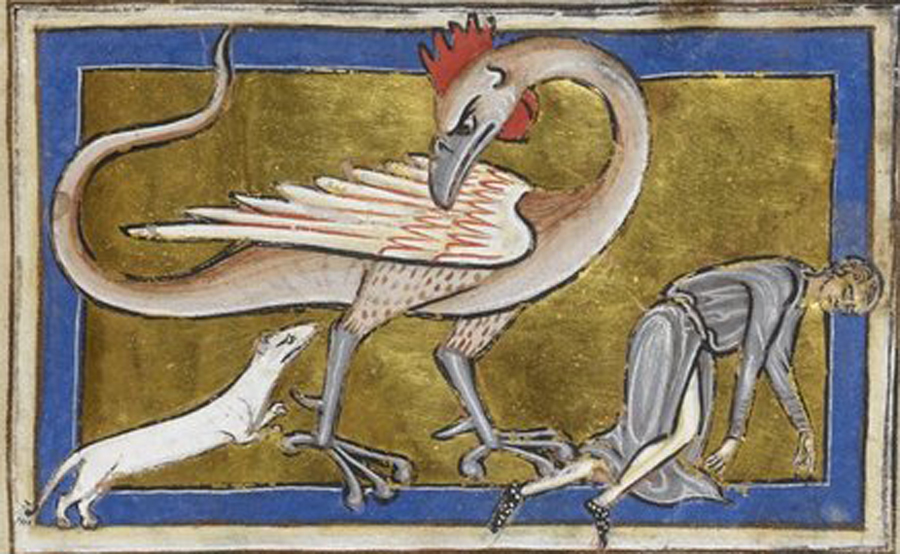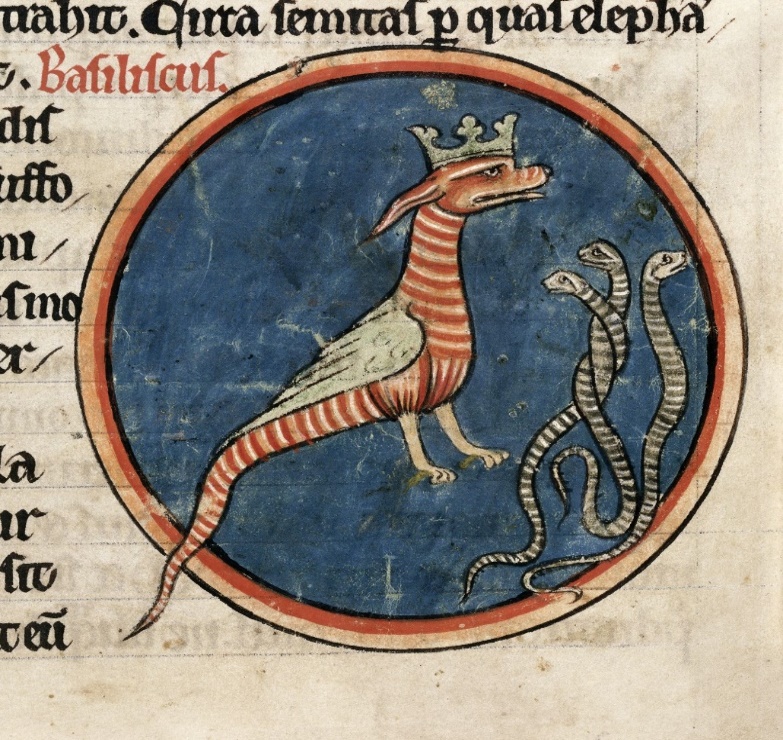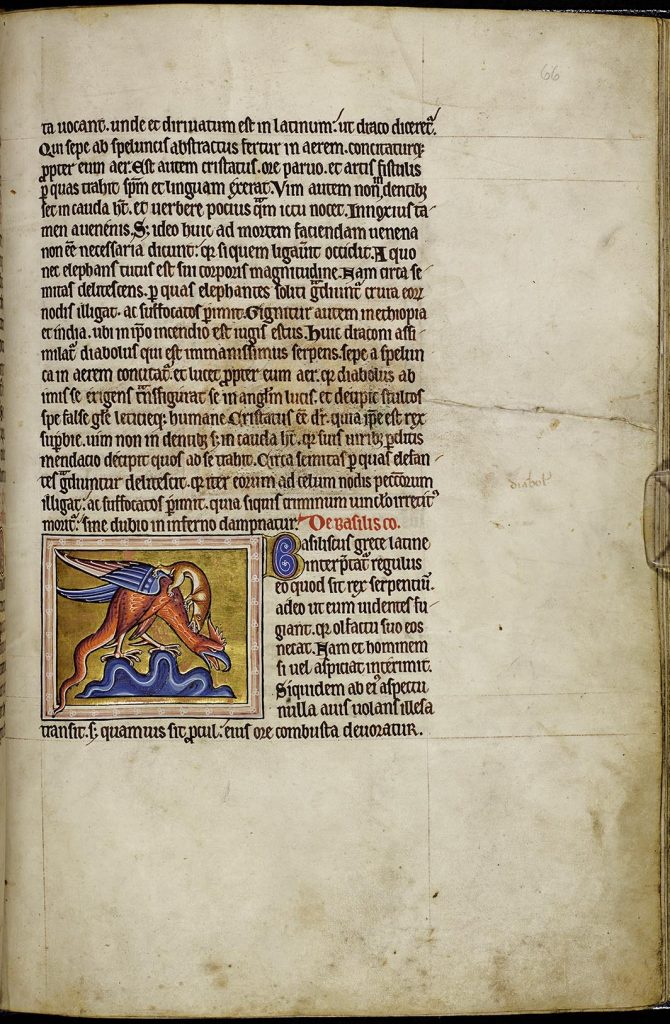It is through the work by J. K. Rowling that most people now have an idea about the basilisk today. She is famously quoted describing the beast, ‘…Its methods of killing are more wonderous, for aside from its deadly and venomous fangs, the Basilisk has a murderous stare and all who are fixed with the beam of its eye shall suffer instant death…’ (Rowling, 1998).
Descending from the Greek text, Physiologus, bestiaries were popular among medieval monasteries (and later, private collectors of literature) but not part of any university curriculum (Sobol,1993). With the expansion of Western Christianity, new cultures and beasts were encountered and their tales and descriptions spread far and wide through travel writing (Cybulskie, 2017). Many medieval artists produced unearthly pictures of the mysterious beasts basing on the descriptions they mingled with their imagination and knowledge. As cited by Sobol, George and Yapp emphasise that English bestiaries are not just a collection of Christian moral direction and old wives’ tales but rather magnificent works of natural history that greatly enlarge upon the Physiologus (Sobol,1993).
Among the most feared of these fantastic medieval beasts was the combatant basilisk whose entire being was a deadly weapon to all creatures.

Figure 1: Basilisk, Bestiary, London, British Library, Royal 12 C XIX, f. 63, circa 1200-1225.

Figure 2: Basilisk, Bestiary, London, British Library, Harley 4751, f. 59, circa 1225-1250.
Compared to the real basilisk, the medieval basilisk was more of a fictional beast. Also known as the Basiliscus, Cockatrice or Sibilus, the basilisk was very popular during medieval times. It was considered the most poisonous serpent whose victims were just as deadly due to the high levels of poison ingested before their demise. A single sniff or touch of their bodies would instantly kill. Although described by St. Isidore as a reptilian cock with eight legs and a crown, the creature is mostly speculative (Alexander, 1963). This resemblance to a cock stemmed from the medieval ideology about the bird’s vigilance in announcing dawn and inspiring fear in a lion (Casagrande and Kleinhenz, 1985). Late medieval descriptions portrayed the basilisk beast as a two or four-legged cock endowed with a red kingly crown and a spear-like serpent’s tail. It was well described, defined, and widely drown. This made it a very familiar beast during medieval times.
Through the ages, the basilisk’s descriptions transformed, and it assumed more destructive powers and fame. It gained the rank of ‘Little king’ or ruler of all serpents and later a Latin name ‘sibilus’ meaning ‘Hiss’. The basilisk could kill a person, not only with its eyes but also with its breath and touch. Its abilities stretched to as far as contaminating water, rendering it poisonous for centuries (Casagrande and Kleinhenz, 1985).
Early lexicographers and encyclopaedists did not include dimorphous descriptions of the beast. According to Casagrande and Kleinhenz’s citing of Hildegard of Bingen’s Physica, the basilisk was an anomaly born of worms and the hatching of a serpent’s or hen’s egg. The account given by Pierre de Beauvais in the early thirteenth century recounts that an egg forms inside a seven-year-old cock. As times passes, the cock lays the egg underground and on smelling the venom inside the egg, the toad watches the egg in hope of hatching it and when it does, the emerging beast has the upper body of a cock and the lower body of a snake (Casagrande and Kleinhenz, 1985).
With all its substantial and mighty abilities, the basilisk’s fragility lies with the weasel. Although the basilisk’s bite could kill the weasel, that little filthy animal’s stink could easily kill the powerful basilisk. According to the catholic church, the weasel was used to refer to people that had knowledge about God but then did not change their ways; people destined to perish. Weasels were put in holes where the basilisk was suspected to be (The University of Aberdeen, 2021). It could also be concluded that the medieval people chose the weasel because it was readily available but inedible and harmless to humans. Thus, an abundantly available solution against the mysterious basilisk.

Figure 3: The Weasel attacks the Basilisk, Aberdeen Bestiary, University of Aberdeen MS 24, f. 66r, c. 1200.
The Aberdeen Bestiary | The University of Aberdeen (abdn.ac.uk)
From the various descriptions available about the Basilisk, it can be deduced that medieval cultures were rich in content and imagination played an important role. The literature almost always contained a moral to be learnt but the actual details could easily be made up to intensify the desired effect. People had knowledge limited to their surrounding and so when they heard about strange creatures like the basilisk which emanated from stories told by the wealthy and educated clergy or upper-class travellers, they could not dispute such information.
Pliny the Elder (c.24- 79 AD) had already dismissed most of the medieval attributes given to the serpent. He argued that some descriptions of the basilisk could have originally referred to snakes which glided on the ground with their middle section raised (Pliny, Nat. Hist. 8.33).
Medieval people saw their rulers or kings as strong and ruthless figures. For example, the name ‘Basilisk’ means ‘little king’ and the snake had impressive powers to kill, seemingly effortlessly at times. With enormous powers over their people, e.g., to enforce legislation in every court of the realm, the attributes the kings commanded were mirrored in the legends of the ‘little king’ serpent over the years.
Basilisk was a psychological warfare symbol. It was inscribed on castle walls, palaces, and homes of wealthy individuals to deter attackers in medieval times, for example, in the city of Basel, where the Basilisk was depicted on the Bishop’s and the city’s heraldic crest.
To conclude therefore, the basilisk was popularly known but also dreaded by medieval people. While the church used it as an example of the creatures of hell that await sinners, the upper-classes used it as a symbol for psychological warfare. Rulers at the time were expected to be monstrous when dealing with enemies and attributing such qualities to the basilisk made it a serpent to be dreaded; the ‘little king’ indeed. No such animal was ever recorded to be sighted although many of its attributes matched a variety of other animals like the cock and the cobra. Nonetheless it is a fantastic medieval beast.
Post by FATUMA MWOGEZA


